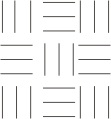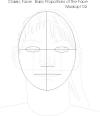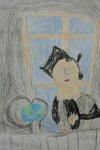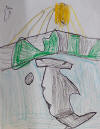|
| |
|
Lesson List:
Click on the title of a lesson to see it's overview. |
| Draw
"Where I Live |
Classic Face |
Christopher Columbus Portrait |
3
Media Picture |
| 5
Line Quality Pic |
Draw
People standing, seated, running |
Haunted House |
Clay
Crosses/Christmas Trees |
|
Surrealist Scribble Pic |
Autumn Tree Watercolor |
Let
It Snow! Drawing |
Snowflake Decoration |
|
Manger Scene Watercolor |
Penguin Watercolor |
Watercolor Butterfly & Crosses |
Drawing Animals: Birds |
|
Turtle Watercolor |
Flower Watercolors |
Butterflies in the Garden of the Lord |
Artist at Work Picture |
| DWG:
Last Supper |
DWG:
Crucifixion |
DWG:
Resurrection |
Crucifixion at Sunset CollageMM |
| MHC
Flag Design Ptg |
Sports Picture |
Papier Mache Animal |
value scale |
| Art
Room Still Life |
|
|
|
|
| Title:Line
Quality: Where I Live |
 |
| Grade Level: 2 |
|
Goals/Objectives (from Graded Course of Study):
C. Media and Techniques
4. Discuss
the composition of a work of art (refer to elements of art and principles
of design, media, and techniques, Goal III)
8.
Identifies themes in art (ideas, events, or relationships important to
individuals and/or society, such as family, work, everyday life, historical
events, etc.)
14. Evaluates
own art work
22.a. LINE
|
|
Artistic/Occupational Influence: It is important to have a good grasp of the
possible applications for various line qualities. |
|
Strategies (to meet needs of different learning styles): n/a |
|
Activities (Step by Step):
1.
BACKGROUND KNOWLEDGE/ SKILL DEVELOPMENT:
On the
chalkboard discuss:
Line
Qualities: Different types of lines which may be used to achieve a
different look or emotional impact. Examples include:
·
thick
·
thin
·
straight
·
wavy
·
zig-zag
·
 broken/dotted broken/dotted
Hatching:
The use of a series of parallel lines to show value and shading.
Value:
The lightness and darkness of a color or object
Texture:
The roughness or smoothness of an object.
Cross
Hatching: XXXXXX crossed hatching
Basket
Weave: 
Herring
Bone
2.
PROJECT:
1.
Explain to class and LINE QUALITY is, demonstrating line qualities on the
chalkboard.
2. Give
each student a pencil and a piece of paper (12 x 18).
3. Assign
the class the subject matter they will have to show, where they live, and
explain tactics for drawing this subject.
4. Make
it clear to the students that they will be responsible for showing at least
5 different line qualities.
5.
Encourage the students to use only lines.
Evaluation: Project will be evaluated for the usage of 5 different line
qualities, good details, good composition, and EFFORT!
|
| Title:Classic
Face |
 |
| Grade Level: 2 |
|
Goals/Objectives (from Graded Course of Study): Identifies
subject matter of art work: Portrait
25.d.
Proportion/Distortion
26.a.
Demonstrates ability to produce Drawings
|
|
Artistic/Occupational Influence: Portraiture |
|
Strategies (to meet needs of different learning styles): Students will be
encouraged to do their best and will be instructed that as long as it looks
human, it's o.k. |
|
Activities (Step by Step):
The instructor will draw an
example on the chalkboard step by step and the students will follow with
their own drawings step by step.
1. Have
students draw a large oval.
    2.
Disect the oval with a horizontal and vertical line. 2.
Disect the oval with a horizontal and vertical line.
3.
Divide the horizontal line into 5 equal spaces.
4. Divide the distance
from the horizontal line to the bottom of the oval in half.
 5.
Divide the distance from this line to the bottom of the oval in half. 5.
Divide the distance from this line to the bottom of the oval in half.
6.
Create ovals for eyes.
7.
Begin placing shapes in place for eyes, nose, mouth, and ears.
8.
Complete drawing and erase guide lines.
9. Add
hair and shade. |
|
Evaluation: As long as the proportions are reasonably close to the
basic proportions of the face, the grade will be good. |
|
Follow-Up: Christopher Columbus Portrait |
| Title:
Christopher Columbus Portrait |

 |
| Grade Level: 2 |
|
Goals/Objectives (from Graded Course of Study):
Identifies subject matter of art work: Portrait
25.d.
Proportion/Distortion
26.a.
Demonstrates ability to produce Drawings
|
|
Artistic/Occupational Influence: Portrait of Christopher Columbus from
late 1600s used as reference. |
|
Strategies (to meet needs of different learning styles): Students will
be encouraged to translate the portrait of Christopher Columbus into their
own interpretation, not merely to copy the original image. |
|
Activities (Step by Step):
Prior to this, students
should be taught the Classic Face portrait progress.
Students should be given a
12 x 18" piece of paper, pencil, crayons, and a copy of the portrait of
Christopher Columbus.
Students will be instructed
to create their own portrait of Christopher Columbus based on the image of
the painting.
Students will be encouraged
to add elements to make this a complete portrait--things which have a
connection with Columbus. |
|
Evaluation: Portraits will be judged on the basis of:
1. Did this look human
using appropriate proportions?
2. Is this reasonably
recognizable as Columbus? |
|
Follow-Up: Portrait skills will be used throughout the year when students
draw people. |
| Title: Draw
People Standing, Sitting, Running |
 |
| Grade Level: 2 |
|
Goals/Objectives (from Graded Course of Study):
Identifies subject matter of art work: Portrait
25.d.
Proportion/Distortion
26.a.
Demonstrates ability to produce Drawings
|
|
Artistic/Occupational Influence: Realism, drawing the figure. |
|
Strategies (to meet needs of different learning styles):n/a |
|
Activities (Step by Step): Students will
be guided to recreate the human body as a series of ovals and positioned to
re-create motion with special emphasis on the way the parts of the body meet
and bend. |
|
Evaluation: verbal feedback, not graded--just an exercise. |
|
Follow-Up: This is basic information and we will use it on virtually every
project. |
|
Title:Halloween House |
Illustration: |
| Grade Level: 2 |
|
Goals/Objectives (from Graded Course of Study): 3. Identifies
subject matter of art work:
Landscape/Architectural
5. Explores
the content or message of a work (include works depicting everyday events,
special events, observations)
22.a. LINE
22.b. SHAPE:
geometric and biomorphic
25.d.
Proportion/Distortion
26.a.
Demonstrates ability to produce Drawings
27.b.
Demonstrates ability to use standard techniques effectively for Crayon
|
|
Artistic/Occupational Influence: Illustrator |
|
Strategies (to meet needs of different learning styles): n/a |
|
Activities (Step by Step): Together, we will draw a picture of a
victorian house on a hill. When the architectural drawing is finished,
students will then add individual elements (trees, fences, etc.) and then
decorate their home for trick or treating. These will then be colored
with crayons. |
|
Evaluation: The architectural drawing and the creativity/skill of the added
elements will be evaluated. |
|
Follow-Up: future architectural drawings. |
| Title: Mary
Cassatt Painting |
Illustration: |
| Grade Level: 2 |
|
Goals/Objectives (from Graded Course of Study): II. Art
History and Culture
III. Art
Production and Expression
C. Media and Techniques
3. Identifies
subject matter of art work:
Portrait
4. Discuss
the composition of a work of art (refer to elements of art and principles
of design, media, and techniques, Goal III)
6.
Identifies a variety of art forms (paintings, murals, ceramics, sculpture, etc.)
18.
Identifies works of art from different periods of history, e.g., Greek,
Renaissance, Impressionist, etc.
26.a.
Demonstrates ability to produce Drawings
26.b.
Demonstrates ability to produce Paintings
27.e.
Demonstrates ability to use standard techniques effectively for Paint
|
|
Artistic/Occupational Influence: Mary Cassatt |
|
Strategies (to meet needs of different learning styles): SStudents
will watch an age-appropriate video on the life of Mary Cassatt as an
introduction to this important female Impressionist. |
|
Activities (Step by Step):
Students will be given an
introduction to Mary Cassatt via a video.
Students will then be given
a print of a Mary Cassatt painting which they will re-interpret as a
drawing.
This drawing will then be
painted using watercolor paints with the emphasis on matching colors and
choppy brushstrokes.
|
|
Evaluation: Students will be evaluated based on the effectiveness of
their re-creation. The goal will be to create something vaguely
recognizable as a Mary Cassatt-esque painting. |
|
Follow-Up: Portraits and paintings in later years. |
| Title:
Surrealist Scribble Picture |
Illustration:
 |
| Grade Level: 2 |
|
Goals/Objectives (from Graded Course of Study): |
|
Artistic/Occupational Influence: |
|
Strategies (to meet needs of different learning styles): |
|
Activities (Step by Step): |
|
Evaluation: |
|
Follow-Up: |
| Title:
Penguins at Play |
Illustration:
 |
| Grade Level: 2 |
|
Goals/Objectives (from Graded Course of Study): |
|
Artistic/Occupational Influence: |
|
Strategies (to meet needs of different learning styles): |
|
Activities (Step by Step): |
|
Evaluation: |
|
Follow-Up: |
| Title:
Watercolor Butterflies |
Illustration: |
| Grade Level: 2 |
|
Goals/Objectives (from Graded Course of Study): |
|
Artistic/Occupational Influence: |
|
Strategies (to meet needs of different learning styles): |
|
Activities (Step by Step): |
|
Evaluation: |
|
Follow-Up: |
| Title:Drawing
Cats, Insects, and Sea Creatures |
Illustration: |
| Grade Level:
2-7 |
|
Goals/Objectives (from Graded Course of Study): 25.d.
Proportion/Distortion
26.a.
Demonstrates ability to produce Drawings
27.b.
Demonstrates ability to use standard techniques effectively for Crayon
27.f.
Demonstrates ability to use standard techniques effectively for Pencil/pen and
ink
|
|
Artistic/Occupational Influence: Illustration |
|
Strategies (to meet needs of different learning styles):
Each student will be evaluated
based upon their age and individual artistic abilities. |
|
Activities (Step by Step): Students will have available to them pages from
Draw 50 Cats, Draw 50 Creepy Crawlies, and Draw 50 Sharks,
Whales, and other Sea Creatures These pages illustrate how to draw
creatures in a step-by-step manner. Using these pages, a 12 x 18"
piece of paper and a pencil, students should draw at least three animals
from the sheets and arrange them in a way to create a complete composition.
Other subject matter must be added to create a foreground, middleground, and
background. These other objects are only limited by the students'
creativity. If they wish, they may mix and match animals from one book
with animals from another, say a cat next to a picnic basket, with ants and
other bugs around. It would obviously be harder to mix and match sea
creatures with cats or insects, unless some level of surrealism is inserted.
When the pencil drawing is completed, it should be colored with either
colored pencils or crayons (crayons are recommended for lower grades).
If students seem to be finishing too quickly, make sure that they are
creating a COMPLETE scene, with adequate supporting objects. This
project should be fun and a little silliness is O.K., but students must
understand that I will expect them to be using the models illustrated on the
pages from the books for their drawings. They should not just make
things up. |
|
Evaluation: This will count as a project grade for grades 2-4, a quiz
grade for grades 5-7. Students will be evaluated on:
--accurate drawing of at least
three animals from the sheets provided.
--a detailed foreground,
middleground, and background which creates a sense of three dimensional
space around the animals.
--craftsmanship and effort
in both drawing and coloring.
|
|
Follow-Up: n/a |
| Title:
Patterned Ocean |
 |
| Grade Level: 2 |
|
Goals/Objectives (from Graded Course of Study): |
|
Artistic/Occupational Influence: |
|
Strategies (to meet needs of different learning styles): |
|
Activities (Step by Step): |
|
Evaluation: |
|
Follow-Up: |
| Title:Manger
Scene Illustration |
Illustration: |
| Grade Level: 2 |
|
Goals/Objectives (from Graded Course of Study):1.
Identifies works of art as realistic, imaginary/fantasy, nonobjective
4.
Discuss the composition of a work of art (refer to elements of art and
principles of design, media, and techniques, Goal III)
8.
Identifies themes in art (ideas, events, or relationships important to
individuals and/or society, such as family, work, everyday life, historical
events, etc.)
17.
Understands how societies express values and beliefs in art work
26.a.
Demonstrates ability to produce Drawings
27.b.
Demonstrates ability to use standard techniques effectively for Crayon
|
|
Artistic/Occupational Influence: Illustrator |
|
Strategies (to meet needs of different learning styles): Encourage the basic
skills to everyone, offer advanced techniques with a "no pressure" attitude. |
|
Activities (Step by Step): The Biblical story of the birth of Jesus should
be read to the class. Discuss what happened, who was there, what the
environment was. Ask the children to act as illustrators telling the
story of the birth of Jesus through their drawings (pencil + crayon).
Encourage realistic figures, animals, and architectural/landscape elements. |
|
Evaluation: Grade |
|
Follow-Up: Other illustration projects. |
| Title: |
Illustration: |
| Grade Level: 2 |
|
Goals/Objectives (from Graded Course of Study): |
|
Artistic/Occupational Influence: |
|
Strategies (to meet needs of different learning styles): |
|
Activities (Step by Step): |
|
Evaluation: |
|
Follow-Up: |
| Title: |
Illustration: |
| Grade Level: 2 |
|
Goals/Objectives (from Graded Course of Study): |
|
Artistic/Occupational Influence: |
|
Strategies (to meet needs of different learning styles): |
|
Activities (Step by Step): |
|
Evaluation: |
|
Follow-Up: |
 Still working on it! Still working on it!
| Title: |
Illustration: |
| Grade Level: 2 |
|
Goals/Objectives (from Graded Course of Study): |
|
Artistic/Occupational Influence: |
|
Strategies (to meet needs of different learning styles): |
|
Activities (Step by Step): |
|
Evaluation: |
|
Follow-Up: |
| Title: |
Illustration: |
| Grade Level: 2 |
|
Goals/Objectives (from Graded Course of Study): |
|
Artistic/Occupational Influence: |
|
Strategies (to meet needs of different learning styles): |
|
Activities (Step by Step): |
|
Evaluation: |
|
Follow-Up: |
| Title: |
Illustration: |
| Grade Level: 2 |
|
Goals/Objectives (from Graded Course of Study): |
|
Artistic/Occupational Influence: |
|
Strategies (to meet needs of different learning styles): |
|
Activities (Step by Step): |
|
Evaluation: |
|
Follow-Up: |
| Title: |
Illustration: |
| Grade Level: 2 |
|
Goals/Objectives (from Graded Course of Study): |
|
Artistic/Occupational Influence: |
|
Strategies (to meet needs of different learning styles): |
|
Activities (Step by Step): |
|
Evaluation: |
|
Follow-Up: |
| Title: |
Illustration: |
| Grade Level: 2 |
|
Goals/Objectives (from Graded Course of Study): |
|
Artistic/Occupational Influence: |
|
Strategies (to meet needs of different learning styles): |
|
Activities (Step by Step): |
|
Evaluation: |
|
Follow-Up: |
| Title: |
Illustration: |
| Grade Level: 2 |
|
Goals/Objectives (from Graded Course of Study): |
|
Artistic/Occupational Influence: |
|
Strategies (to meet needs of different learning styles): |
|
Activities (Step by Step): |
|
Evaluation: |
|
Follow-Up: |
| Title: |
Illustration: |
| Grade Level: 2 |
|
Goals/Objectives (from Graded Course of Study): |
|
Artistic/Occupational Influence: |
|
Strategies (to meet needs of different learning styles): |
|
Activities (Step by Step): |
|
Evaluation: |
|
Follow-Up: |
| Title: |
Illustration: |
| Grade Level: 2 |
|
Goals/Objectives (from Graded Course of Study): |
|
Artistic/Occupational Influence: |
|
Strategies (to meet needs of different learning styles): |
|
Activities (Step by Step): |
|
Evaluation: |
|
Follow-Up: |
| Title: |
Illustration: |
| Grade Level: 2 |
|
Goals/Objectives (from Graded Course of Study): |
|
Artistic/Occupational Influence: |
|
Strategies (to meet needs of different learning styles): |
|
Activities (Step by Step): |
|
Evaluation: |
|
Follow-Up: |
| Title: |
Illustration: |
| Grade Level: 2 |
|
Goals/Objectives (from Graded Course of Study): |
|
Artistic/Occupational Influence: |
|
Strategies (to meet needs of different learning styles): |
|
Activities (Step by Step): |
|
Evaluation: |
|
Follow-Up: |
| Title: |
Illustration: |
| Grade Level: 2 |
|
Goals/Objectives (from Graded Course of Study): |
|
Artistic/Occupational Influence: |
|
Strategies (to meet needs of different learning styles): |
|
Activities (Step by Step): |
|
Evaluation: |
|
Follow-Up: |
| Title: |
Illustration: |
| Grade Level: 2 |
|
Goals/Objectives (from Graded Course of Study): |
|
Artistic/Occupational Influence: |
|
Strategies (to meet needs of different learning styles): |
|
Activities (Step by Step): |
|
Evaluation: |
|
Follow-Up: |
| Title: |
Illustration: |
| Grade Level: 2 |
|
Goals/Objectives (from Graded Course of Study): |
|
Artistic/Occupational Influence: |
|
Strategies (to meet needs of different learning styles): |
|
Activities (Step by Step): |
|
Evaluation: |
|
Follow-Up: |
| Title: |
Illustration: |
| Grade Level: 2 |
|
Goals/Objectives (from Graded Course of Study): |
|
Artistic/Occupational Influence: |
|
Strategies (to meet needs of different learning styles): |
|
Activities (Step by Step): |
|
Evaluation: |
|
Follow-Up: |
| Title: |
Illustration: |
| Grade Level: 2 |
|
Goals/Objectives (from Graded Course of Study): |
|
Artistic/Occupational Influence: |
|
Strategies (to meet needs of different learning styles): |
|
Activities (Step by Step): |
|
Evaluation: |
|
Follow-Up: |
| Title: |
Illustration: |
| Grade Level: 2 |
|
Goals/Objectives (from Graded Course of Study): |
|
Artistic/Occupational Influence: |
|
Strategies (to meet needs of different learning styles): |
|
Activities (Step by Step): |
|
Evaluation: |
|
Follow-Up: |
| Title: |
Illustration: |
| Grade Level: 2 |
|
Goals/Objectives (from Graded Course of Study): |
|
Artistic/Occupational Influence: |
|
Strategies (to meet needs of different learning styles): |
|
Activities (Step by Step): |
|
Evaluation: |
|
Follow-Up: |
| Title: |
Illustration: |
| Grade Level: 2 |
|
Goals/Objectives (from Graded Course of Study): |
|
Artistic/Occupational Influence: |
|
Strategies (to meet needs of different learning styles): |
|
Activities (Step by Step): |
|
Evaluation: |
|
Follow-Up: |
| Title: |
Illustration: |
| Grade Level: 2 |
|
Goals/Objectives (from Graded Course of Study): |
|
Artistic/Occupational Influence: |
|
Strategies (to meet needs of different learning styles): |
|
Activities (Step by Step): |
|
Evaluation: |
|
Follow-Up: |
| Title: |
Illustration: |
| Grade Level: 2 |
|
Goals/Objectives (from Graded Course of Study): |
|
Artistic/Occupational Influence: |
|
Strategies (to meet needs of different learning styles): |
|
Activities (Step by Step): |
|
Evaluation: |
|
Follow-Up: |
|